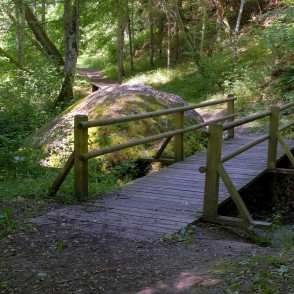Located where the River Runtiņupīte mouthes with River Gauja.
Maximum height is 2.5 m, length – 5.3 m, width – 3.7 m. The volume of the stone is estimated around 25 m3. In terms of composition it is a pegmatite with course granite inclusions. Out of a small sandstone outcrop near the stone flows a powerful spring.
www.entergauja.com
Description
The Big (Devil’s) Stone lies on the right bank of the Gauja River at the very beach near the mouth of a brook crossed by a small bridge. The height of the stone is from 1.1 to 2.5 metres, length 5.3 metres, width 3.7 metres. It is mainly composed of reddish pegmatite with raw crystallic granite inclusions. The Big Stone once used to lie on the very bank of the Gauja River. It was also called Runtiņš Spring Stone because a rapid spring is starting here. Nearby in ancient times there used to be a raft wharf. An iron loop cemented in a raftsmen’s anchor block has been preserved. The stone is big, monolith, covered with moss, however, no artificial signs or cavities can be found in the stone. In the vicinity of the stone there are several other small stones. Judging by the name and legend the Devil’s Stone can be considered a shrine with a mythological significance.
Narrative
Once in Sigulda at the Gauja River the Devil was carrying stones wishing to dam the rafters’ way. All of a sudden a rooster sang and the shirt were the Devil was carrying stones was torn and the stones fell into the Gauja. There are still big stones in the Gauja River near to its bank. LFK, 1860, 4654, FI IV scientific expedition, narrator A. Irbīte, 65 years old, 1950.
Comments
The stone has been included in the Pārgauja path and there are several indications and descriptions of it in various places. There is an information plate at the stone. The stone can be accessed by following a marked path along the Gauja River or by walking down from the path/small road from the New Cemetery of Krimulda, i.e., from the brink of the primeval hollow of the Gauja River. Downwards from the Devil’s Stone on the right bank of the Gauja River there is a well-arranged recreation place with a place for making fire, wooden log table and bench. The territory of the Gauja National Park.
www.ancientsites.lv





